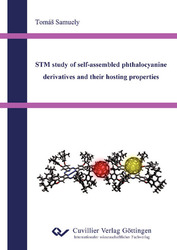| Fachbereiche | |
|---|---|
| Buchreihen (96) |
1378
|
| Nachhaltigkeit |
3
|
| Gesundheitswesen |
1
|
| Geisteswissenschaften |
2364
|
| Naturwissenschaften |
5406
|
| Mathematik | 229 |
| Informatik | 319 |
| Physik | 980 |
| Chemie | 1363 |
| Geowissenschaften | 131 |
| Humanmedizin | 243 |
| Zahn-, Mund- und Kieferheilkunde | 10 |
| Veterinärmedizin | 108 |
| Pharmazie | 147 |
| Biologie | 835 |
| Biochemie, Molekularbiologie, Gentechnologie | 121 |
| Biophysik | 25 |
| Ernährungs- und Haushaltswissenschaften | 45 |
| Land- und Agrarwissenschaften | 1004 |
| Forstwissenschaften | 201 |
| Gartenbauwissenschaft | 20 |
| Umweltforschung, Ökologie und Landespflege | 148 |
| Ingenieurwissenschaften |
1793
|
| Allgemein |
98
|
|
Leitlinien Unfallchirurgie
5. Auflage bestellen |
|
Erweiterte Suche
STM study of self-assembled phthalocyanine derivatives and their hosting properties
Tomas Samuely (Autor)Vorschau
Inhaltsverzeichnis, Datei (27 KB)
Leseprobe, Datei (520 KB)
Molecular self-assembly, as a most studied case of self-assembly, is one of the
few practical strategies for making ensembles of nano- and micro structures. As an
essential aspect of the “bottom-up” approach, it is attractive for both scientific research
and technological applications. Therefore a detailed understanding of the moleculesubstrate
and intermolecular interactions involved in the self-assembly process is of great
interest.
In the first part of the thesis, the influence of the phenoxy substituents on the selfassembly
of Pcs on (111)-oriented noble metal surfaces is described. The rotational
degrees of freedom, characteristic for these substituents enable the formation of various
stable and transient phases and allow the substituents to be arranged above the plane of
the Pc core, forming a bowl-like structure, which in turn enables the interaction of the Pc
core with the metal substrate. The proximity of the Pc core to the metal substrate together
with the steric entanglement between neighboring substituents causes significant
retardation of the thermodynamic optimization of the conformations. This accounts for
the coexistence of some of the phases.
In the second part, the influence of replacing two adjacent phenoxy substituents
by a rigid tetraazatriphenylene substituent on the self-assembly of Pcs is analyzed and
compared to the self-assembly of the above mentioned phenoxy substituted Pcs. The rigid
substituent enhances the rotational degrees of freedom of the neighboring phenoxy
substituents, hence facilitates their conformational optimization. As a result, novel
interactions between the Pc derivatives are enabled and the formation of ordered phases
with higher surface densities compared to the previous study is observed.
In the third part, the hosting properties of a close-packed layer of phenoxy
substituted Pc derivatives adsorbed on Ag(111) are investigated for the adsorption of C60
molecules. The C60 molecules bind to two clearly distinguishable sites, either to the
underlying metal substrate in between two adjacent Pc derivatives or to the core of a Pc
derivative. In the first case, the C60 exhibit morphologic and electronic properties
analogous to those of a C60 adsorbed on clean Ag(111), whereas in the second case the
electronic properties indicate a strong interaction between C60 and the phthalocyanine
core.
| ISBN-13 (Printausgabe) | 386727830X |
| ISBN-13 (Printausgabe) | 9783867278300 |
| ISBN-13 (E-Book) | 9783736928305 |
| Buchendformat | A5 |
| Sprache | Englisch |
| Seitenanzahl | 66 |
| Auflage | 1 Aufl. |
| Band | 0 |
| Erscheinungsort | Göttingen |
| Promotionsort | Univesität Basel |
| Erscheinungsdatum | 15.12.2008 |
| Allgemeine Einordnung | Dissertation |
| Fachbereiche |
Chemie
Biologie |








